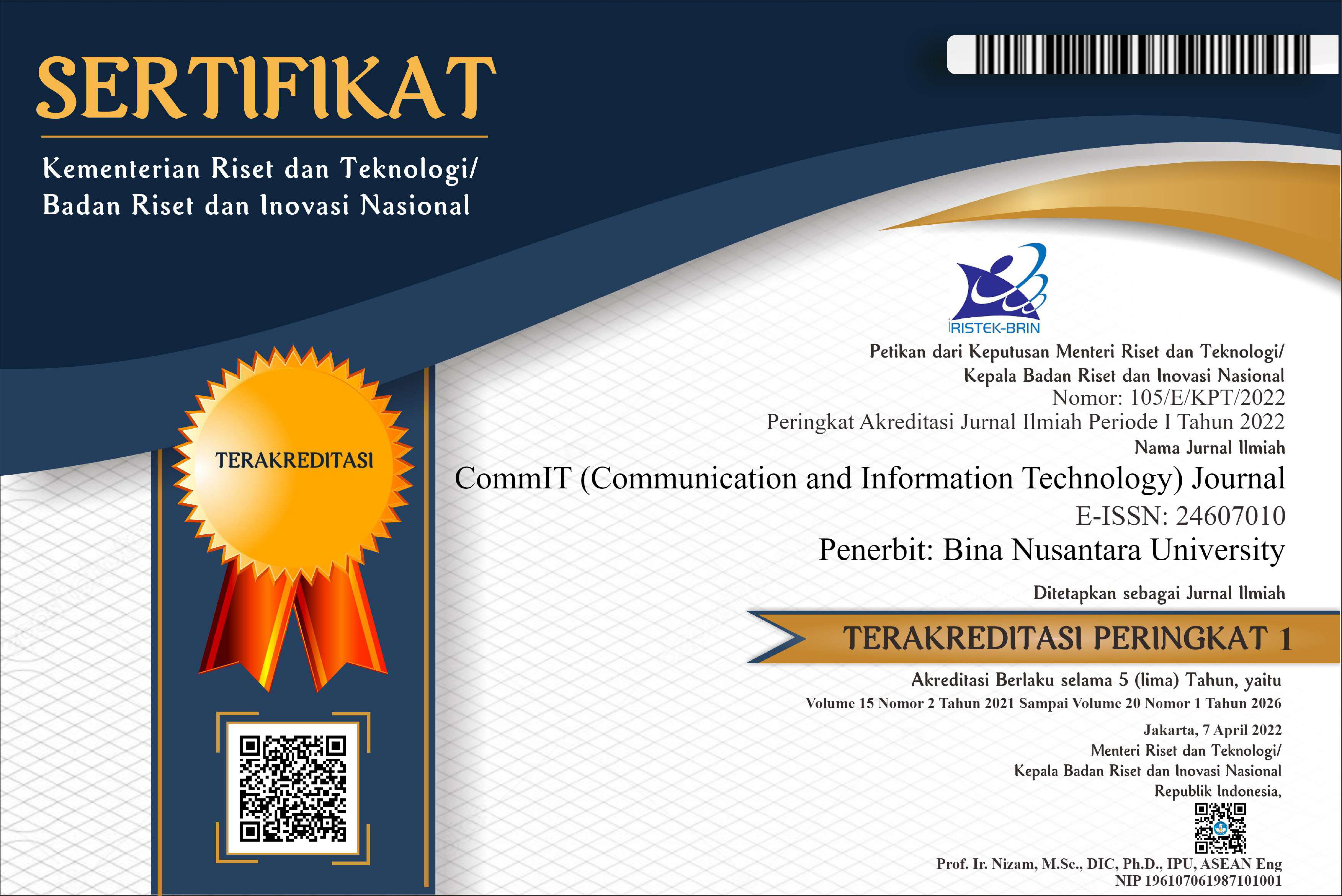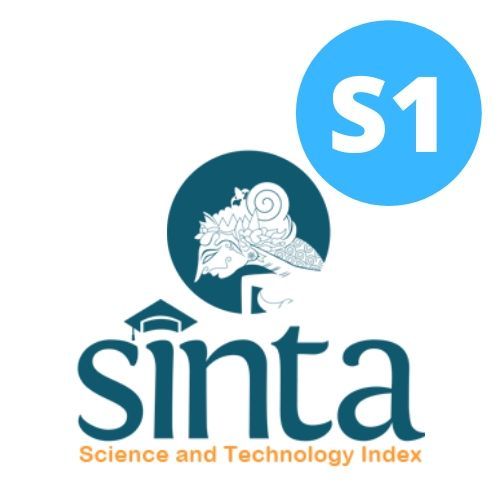Performance of Clustering on ANFIS for Weather Forecasting
DOI:
https://doi.org/10.21512/commit.v12i1.3941Keywords:
ANFIS, Fuzzy C-Means, K-Means, Weather ForecastingAbstract
This paper proposes the comparison of using K-Means and Fuzzy C-Means (FCM) to optimize the premise parameters on Adaptive Neuro-Fuzzy Inference System (ANFIS) for weather forecasting. The ANFIS architecture groups each of the feature inputs in the first layer into three clusters, and uses three rules for the second layer. The comparison is performed based on the RMSE value and the number of iteration. The testing is done on the percentage of 40%, 50%, and 60% of the total data. In addition, the testing is done by grouping the data based on season called rainy and dry seasons. The testing results show that both K-Means and FCM have
almost the same RMSE, except for rainy season where K-Means has better RMSE. However, K-Means requires relatively more iterations to achieve convergence. The use of FCM, in general, gives better results than K-Means. It is also shown that ANFIS provides the best performance for data onto the dry season.
Plum Analytics
References
K. Shereef and S. S. Baboo, “A new weather forecasting technique using back propagation neural network with modified levenberg-marquardt algorithm for learning,” IJCSI International Journal of Computer Science, vol. 8, no. 6, pp. 1694–0814, 2011.
D. Singhal and K. Swarup, “Electricity price forecasting using artificial neural networks,” International Journal of Electrical Power & Energy Systems, vol. 33, no. 3, pp. 550–555, 2011.
W. Ya¨ıci and E. Entchev, “Performance prediction of a solar thermal energy system using artificial neural networks,” Applied Thermal Engineering, vol. 73, no. 1, pp. 1348–1359, 2014.
F. Rodrigues, C. Cardeira, and J. M. F. Calado, “The daily and hourly energy consumption and load forecasting using artificial neural network method: a case study using a set of 93 households
in portugal,” Energy Procedia, vol. 62, pp. 220–229, 2014.
E. Avunduk, D. Tumac, and A. Atalay, “Prediction of roadheader performance by artificial neural network,” Tunnelling and Underground Space Technology, vol. 44, pp. 3–9, 2014.
F. J. Chang, P. A. Chen, Y. R. Lu, E. Huang, and K. Y. Chang, “Real-time multi-step-ahead water level forecasting by recurrent neural networks for urban flood control,” Journal of Hydrology, vol.
, pp. 836–846, 2014.
W. Du, S. Y. S. Leung, and C. K. Kwong, “Time series forecasting by neural networks: A knee point-based multiobjective evolutionary algorithm approach,” Expert Systems with Applications, vol. 41, no. 18, pp. 8049–8061, 2014.
J. Z. Zhu, J. X. Cao, and Y. Zhu, “Traffic volume forecasting based on radial basis function neural network with the consideration of traffic flows at the adjacent intersections,” Transportation Research Part C: Emerging Technologies, vol. 47, pp. 139–154, 2014.
N. A. S¸ is¸man-Yılmaz, F. N. Alpaslan, and L. Jain, “ANFIS unfolded in time for multivariate time series forecasting,” Neurocomputing, vol. 61, pp. 139–168, 2004.
L. C. Ying and M. C. Pan, “Using adaptive network based fuzzy inference system to forecast regional electricity loads,” Energy Conversion and Management, vol. 49, no. 2, pp. 205–211, 2008.
M. Mohandes, S. Rehman, and S. Rahman, “Estimation of wind speed profile using Adaptive Neuro-Fuzzy Inference System (ANFIS),” Applied Energy, vol. 88, no. 11, pp. 4024–4032, 2011.
J. Nou, R. Chauvin, A. Traor´e, S. Thil, and S. Grieu, “Atmospheric turbidity forecasting using side-by-side ANFIS,” Energy Procedia, vol. 49, pp. 2387–2397, 2014.
L. Yang and E. Entchev, “Performance prediction of a hybrid microgeneration system using Adaptive Neuro-Fuzzy Inference System (ANFIS) technique,” Applied Energy, vol. 134, pp. 197–203, 2014.
J. S. R. Jang, C. T. Sun, and E. Mizutani, “Neurofuzzy and soft computing; a computational approach to learning and machine intelligence,” IEEE Transactions on Automatic Control, vol. 42, no. 10, pp. 1482–1484, 1997.
F. An and H. J. Mattausch, “K-means clustering algorithm for multimedia applications with flexible hw/sw co-design,” Journal of Systems Architecture, vol. 59, no. 3, pp. 155–164, 2013.
J. Cao, Z. Wu, J. Wu, and W. Liu, “Towards information-theoretic k-means clustering for image indexing,” Signal Processing, vol. 93, no. 7, pp. 2026–2037, 2013.
M. G. Di Giuseppe, A. Troiano, C. Troise, and G. De Natale, “k-means clustering as tool for multivariate geophysical data analysis. an application to shallow fault zone imaging,” Journal of Applied Geophysics, vol. 101, pp. 108–115, 2014.
S. Adhau, R. Moharil, and P. Adhau, “K-means clustering technique applied to availability of micro hydro power,” Sustainable Energy Technologies and Assessments, vol. 8, pp. 191–201, 2014.
M. I. Malinen, R. Mariescu-Istodor, and P. Fr¨anti, “K-means?: Clustering by gradual data transformation,” Pattern Recognition, vol. 47, no. 10, pp. 3376–3386, 2014.
S. Kannan, S. Ramathilagam, and P. Chung, “Effective fuzzy c-means clustering algorithms for data clustering problems,” Expert Systems with Applications, vol. 39, no. 7, pp. 6292–6300, 2012.
X. Y. Wang and J. Bu, “A fast and robust image segmentation using FCM with spatial information,” Digital Signal Processing, vol. 20, no. 4, pp. 1173–1182, 2010.
S. Kannan, R. Devi, S. Ramathilagam, and K. Takezawa, “Effective FCM noise clustering algorithms in medical images,” Computers in Biology and Medicine, vol. 43, no. 2, pp. 73–83,
S. Ghaffarian and S. Ghaffarian, “Automatic histogram-based fuzzy c-means clustering for remote sensing imagery,” ISPRS Journal of Photogrammetry and Remote Sensing, vol. 97, pp.
–57, 2014.
B. R. Jipkate and V. Gohokar, “A comparative analysis of fuzzy c-means clustering and k means clustering algorithms,” International Journal of Computational Engineering Research, vol. 2, no. 3, pp. 737–739, 2012.
Q. Wen and M. E. Celebi, “Hard versus fuzzy c-means clustering for color quantization,” EURASIP Journal on Advances in Signal Processing, vol. 2011, no. 1, p. 118, 2011.
T. Velmurugan and T. Santhanam, “Performance evaluation of k-means and fuzzy c-means clustering algorithms for statistical distributions of input data points,” European Journal of Scientific
Research, vol. 46, no. 3, pp. 320–330, 2010.
I. Shanthi and M. Valarmathi, “Comparison of fuzzy c-mean clustering and k-means clustering for sar image despeckling using edge detection,” European Journal of Scientific Research, vol. 62,
no. 3, pp. 426–437, 2011.
H. Purnomo and S. Kusumadewi, Aplikasi logika Fuzzy untuk pendukung keputusan. Yogyakarta: Graha Ilmu, 2010.
Downloads
Published
Issue
Section
License
Authors who publish with this journal agree to the following terms:
a. Authors retain copyright and grant the journal right of first publication with the work simultaneously licensed under a Creative Commons Attribution License - Share Alike that allows others to share the work with an acknowledgment of the work's authorship and initial publication in this journal.
b. Authors are able to enter into separate, additional contractual arrangements for the non-exclusive distribution of the journal's published version of the work (e.g., post it to an institutional repository or publish it in a book), with an acknowledgment of its initial publication in this journal.
c. Authors are permitted and encouraged to post their work online (e.g., in institutional repositories or on their website) prior to and during the submission process, as it can lead to productive exchanges, as well as earlier and greater citation of published work.
USER RIGHTS
All articles published Open Access will be immediately and permanently free for everyone to read and download. We are continuously working with our author communities to select the best choice of license options, currently being defined for this journal as follows: Creative Commons Attribution-Share Alike (CC BY-SA)




















